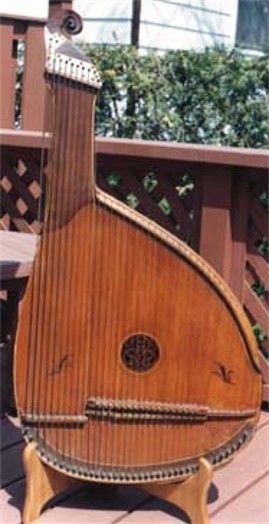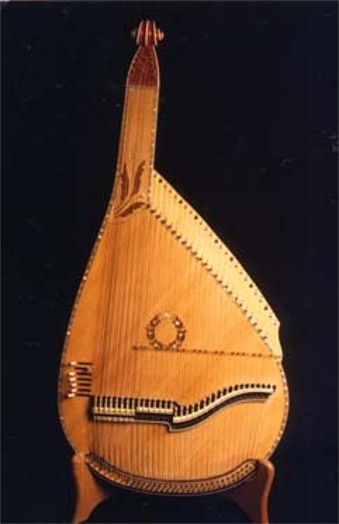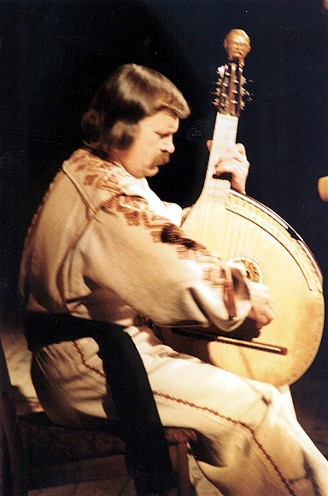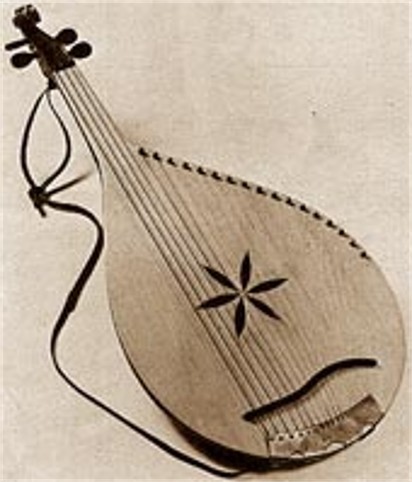Bandura
Bandura. A Ukrainian musical instrument similar in construction and appearance to a lute. The bandura has 32–55 strings: the 8–14 bass strings (bunty) are stretched along the neck, and the 24–43 treble strings (prystrunky) run along the side of the soundboard. Before the 20th century the bandura had various shapes and tunings (basically diatonic), but in recent times it has been standardized. The modern bandura is usually chromatic, with a basic tuning in G major/E minor; the range is from AA to G3. The Chernihiv bandura is 109 cm by 51 cm in size. The bandura differs from other lutelike instruments by the presence of the prystrunky, on which the melody is performed (the bunty are used only for accompaniment), and the absence of frets. Each string produces only one note.
The body (koriak) of the bandura is usually made from sycamore, cherry, maple, or red willow. The treble nut (obychaika) and pin collar (strunnyk) are made from maple or beech, and the sound board (deka) from spruce. In the modern bandura steel strings are used, the lower ones being wound with copper, brass, or bronze. Until the 20th century wooden turning pegs were used, but these have been replaced by metal pins for greater tonal stability.
The more popular Chernihiv bandura is placed in the lap of the bandura player (banduryst) at an angle to the body. The melody is played with the right hand, the accompaniment with the left. In the Kharkiv (Zinkiv) method the bandura is placed in the performer's lap parallel to the body, the left hand reaches over the obychaika to play on the prystrunky, and the right hand plays on the bunty. These methods require somewhat different instruments.
The oldest record of a bandura-like instrument in Ukraine is an 11th-century fresco of court musicians (skomorokhy) in the Saint Sophia Cathedral in Kyiv. This lute-like instrument is probably the ancestor of the bandura and the kobza. The two instruments were related, but distinct. The kobza was smaller in size and had fewer strings, but these were fretted. Around the 16th century prystrunky were added to the bandura, and from that time only one note was obtained from each string. During the 17th and 18th century the bandura was very popular at the Zaporozhian Sich, among the common people, and at the gentry manors. In the 18th century the bandura displaced the kobza, and both names are now used synonymously. Old banduras were symmetrical. Their shape limited the number of prystrunky and thus the range of the instrument. In 1894 Hnat Khotkevych designed an asymmetrical bandura, thus increasing its range.
Many attempts were made in the 20th century to turn the bandura into a chromatic instrument. Some banduras, such as the Chernihiv bandura, use an additional set of strings for the semitones; others use a mechanism for retuning individual strings by a semitone; and some banduras employ both devices. V. Herasymenko, O. Korniievsky, Ivan Skliar, S. Snihyriov, V. Tuzychenko, and others have contributed to the technical improvement of the instrument. For larger ensembles, banduras of different ranges have been designed—the pryma (piccolo), alto, bass, and contrabass. Owing to the efforts of Mykola Lysenko, Hnat Khotkevych, and others, bandura playing began to be studied in the 20th century at music schools and other educational institutions. Instrumental-vocal ensembles and kapellen were organized at the same time.
BIBLIOGRAPHY
Lysenko, M. ‘Narodni muzychni instrumenty na Ukraïni,’ Zoria (1894; repr Kyiv 1955)
Iemets', V. Kobza ta kobzari (Berlin 1922)
Khotkevych, H. Muzychni instrumenty ukraïns'koho narodu (Kharkiv 1930)
Lastovych-Chulivs’kyi, S. Lysty pro banduru (New York 1956)
Humeniuk, A. Ukraïns’ki narodni muzychni instrumenty (Kyiv 1967)
Skliar, I. Kyïvs’ko-kharkivs’ka bandura (Kyiv 1971)
Andrij Hornjatkevyč
[This article originally appeared in the Encyclopedia of Ukraine, vol. 1 (1984).]

.jpg)



